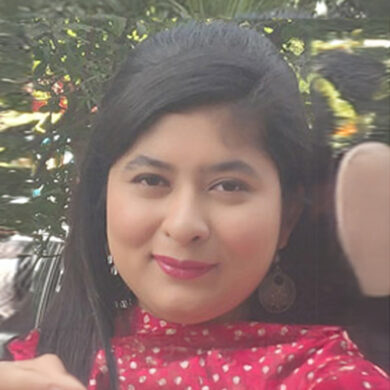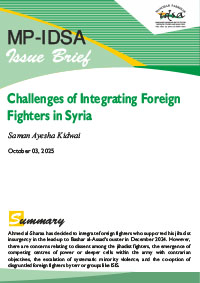Challenges of Integrating Foreign Fighters in Syria
- October 03, 2025 |
- Issue Brief
Summary
Ahmed al-Sharaa has decided to integrate foreign fighters who supported his jihadist insurgency in the lead-up to Bashar al-Assad’s ouster in December 2024. However, there are concerns relating to dissent among the jihadist fighters, the emergence of competing centres of power or sleeper cells within the army with contrarian objectives, the escalation of systematic minority violence, and the co-option of disgruntled foreign fighters by terror groups like ISIS.
Syria’s new leader, Ahmed al-Sharaa’s decision to remake the Syrian army, mainly through integrating the approximately 5,000 foreign fighters (FF) who played a role in his revolutionary endeavour, entails risks.[i] The Syrian Ministry of Defence is gearing up to be the nodal body coordinating the activities of various armed factions, including the foreign fighters who backed al-Sharaa and his Hayat Tahrir al-Sham (HTS) path to victory in 2024. Comprising approximately 30 per cent[ii] – 3,500 – of the new armed personnel, the foreign fighters (mostly Uyghurs belonging to the now-disbanded Turkistan Islamic Party) have gradually begun to be consolidated within the 84th unit of the Syrian Arab Army. Citizenship for the foreign fighters and their families has been presented as an incentivising pathway to forsake factional interests and arms that do not fall under the purview of the Ministry and al-Sharaa’s power centralisation agenda. Their loyalty to the leadership, however, remains a concern.
Al-Sharaa has secured[iii] the approval of President Donald Trump to integrate the foreign fighters into the national army. It is a remarkable shift from the previous U.S. dictate to remove the physical presence of FF from Syria. It could be argued that the driving forces of this development are twofold. One aspect is related to American security concerns. The Trump administration might perceive its support for foreign fighters’ integration under a centralised command and cooperation with al-Sharaa as necessary to prevent the re-emergence of splinter groups with a hostile approach towards the U.S. The other presumably concerns al-Sharaa’s ambition to prevent the country from sliding back into a civil war rife with competing factions who have gained significant battle experience, if only to avoid any obstacles to his power centralisation agenda.
To that effect, at least 12 per cent[iv] of fresh senior military roles announced by January 2025, i.e., six out of 50, have been awarded to foreign fighters, possibly to guarantee their loyalty to the new regime. Some of the major appointees include Abdul Samrez Jashari (of Macedonian origin) as a Colonel. The interim regime has appointed[v] Abdul Rahman Hussein al-Khatib (of Jordanian origin) and Abdulaziz Dawood Khudaberdi (of Chinese-Uyghur origin) as Brigadier-Generals. Moreover, analysts like Aaron Zelin have claimed[vi] that the integration of foreign fighters is driven foremost by one key motive –
“…(Jolani) is trying to potentially indigenize them and make them Syrian… better for them to be integrated and following HTS’s new role than them freelancing, or at least that’s how they (HTS and Jolani) view it.”
As part of the integration and to Syrianise the foreign fighters, Ahmed al-Sharaa is reportedly disseminating Madkhali Salafism, whose core teaching emphasises[vii] obedience to the ruler and disavows rebellion. It is rooted in the belief that living under an unjust ruler is more favourable vis-à-vis chaos and instability. How successful the instilling of these values will be in foreign fighters who have been indoctrinated in a worldview (hardliner Salafism) that focuses on constant jihad and the toppling of governments, remains to be seen.
Concerns with FF Integration
While demonstrable loyalty to the new regime is key to participation in the armed forces and the granting of citizenship, several festering issues remain.
Dissent and Defections
There is the possibility that FF, disenchanted with al-Sharaa’s outreach to the international community, including the United States, France, and Saudi Arabia, could exploit the integration process. They could covertly re-arm or bolster their access to arms and ammunition and push the country back into the throes of armed conflict. Meanwhile, those who perceive al-Sharaa weaning away from jihadist leanings in pursuit of diplomatic engagement, recognition, and the lifting of all sanctions would be at greater risk of being co-opted by more hardliner groups like ISIS.
A comparison could be drawn here between Syria and Afghanistan, where reports emerged about defections within the Afghan Taliban by fighters who later joined the Islamic State in Khorasan Province due to the interim Afghan leadership’s alleged abandonment of jihad. It was also the case with the Tehreek-e-Taliban Pakistan, or the Pakistani Taliban, which saw large-scale defections by those who were disillusioned by its nationalistic jihadist outlook and ceasefire efforts with the federal government, and who wanted to pursue a global jihad as preached by ISIS.
Despite the fall of its physical Caliphate in March 2019, ISIS continues operating in Syria. Notably, ISIS propaganda, particularly through its al-Naba publication, became rampant following al-Sharaa’s seizure of Damascus. One of the editorials declared[viii] al-Sharaa an apostate, citing his interactions with foreign leaders while calling on disenchanted Islamists, including those formerly associated with HTS, to re-establish ties with ISIS. Notably, under al-Sharaa, HTS had first severed ties with ISIS and later, al-Qaeda.
A Challenging Balancing Act
With the downfall of the al-Assad dynasty, the Syrians have gradually expressed a greater desire to experience stability, security, and freedom vis-à-vis the past. As the hardliners, riding on their success in ousting Bashar al-Assad, also seek greater influence in shaping the trajectory of Syria, they have pushed back against the new regime’s attempts to appease some of the moderates by hosting a ceremony based on the Paralympic Games. Due to the harsh rebuke faced by the interim administration, it has now chosen to reassess its decision to permit the organisation of such activities.[ix]
There have also been concerning reports, however, that foreign fighters accused[x] of war crimes have been integrated into the Syrian army. This raises questions about the government’s posturing toward ethnic minorities and the legitimacy of the commitments it may make with foreign governments through diplomatic channels.
For now, the interim regime has also relied on a delicate balance to retain the support of the hardliners. This has included rejecting[xi] calls made by the United States and the United Nations to send their representatives to the National Dialogue held in February 2025, which is believed to have convinced the jihadists that the U.S.-led Western world would not co-opt the new leader.
Meanwhile, al-Shaara has engaged with the international community, presumably in a bid to assuage the concerns expressed by his critics. After all, the new interim President interacted with members of the U.S. House Foreign Affairs Committee and the Secretary of State, Marco Rubio, on the sidelines of the 80th Session of the United Nations General Assembly. There, he renewed the call for lifting sanctions on Syria.
He also attended the Doha Summit convened on 15 September 2025. Al-Sharaa used the emergency Summit in Qatar to consolidate regional support for his continued rule as he condemned the Israeli strike, which killed Hamas officials and a Qatari security guard, and extended his support to Qatar. He also highlighted that Israel has been targeting his country in the past year and condemned Israeli actions in the Gaza Strip.[xii]
Minority Persecution
Ethnic minorities appear to be in the crosshairs of the wrath unleashed by the Sunni Islamists who are now formally part of the Syrian Army. The lack of sensitisation training given to the foreign fighters and stringent oversight to ensure they shed their jihadist orientation has resulted in widespread violence against the vulnerable communities. The broader consensus among security experts is a forewarning[xiii] that must not be dismissed – “You cannot integrate people who see Christians, Alawites, and Druze as apostates. You’re building a state on a minefield.” There is also a prevailing sense of insecurity among Syrian activists due to the Islamisation[xiv] of the school curriculum. In March 2025, Syria’s coastal regions witnessed the onslaught of sectarian violence carried out by the integrated foreign fighters, leaving numerous Alawites (over 1,500)[xv] dead. In its aftermath, two foreign fighters – Sayf Bulad and Mohammad al-Jasem – were promoted[xvi] within the armed forces.
Additional Security Concerns
One of the other key issues that has sprung up is related to the systematic deprivation of power and prestige to the appointees of the Assad era across the health, intelligence, police, bureaucracy, and armed forces sectors. On the one hand, while some commentators have pointed out that the Syrian state has become even more “dysfunctional because of some of the steps that he (al-Sharaa) has taken.”[xvii]
A parallel could be drawn with the restructuring carried out in post-Saddam Iraq. During that era, the Sunni community was systematically targeted, prosecuted, and shunted from state affairs, administrative positions, and governance structures to centralise power in the hands of the Shia community. Over time, the deliberate power and administrative restructuring fomented the sectarian fault lines that led to the rise of al-Qaeda in Iraq and later ISIS. Ahmed al-Sharaa could, therefore, find himself replacing Iraq’s Nouri al-Maliki as the harbinger of a new wave of Islamist terrorism in West Asia.
Interestingly, al-Sharaa traces[xviii] his family lineage to the Alawite community (established through paternal links). However, he has been associated with Salafi-jihadi terror groups like ISIS and later al-Qaeda, as well as Sunni jihadist factions, to secure power and influence. He has preferred the ideological groupings that brought him fortune, notoriety, and success instead of his kinship ties. This is an essential demonstration of his ruthless pragmatism in pursuit of goals that further his interests and the consolidation of power.
Furthermore, there is also the concern that foreign fighters, including those in private jihadist mercenary groups like the Albanian Tactical and Malhama Tactical (comprising Dagestanis, Kyrgyz, Chechens, and Uzbeks), have shied away from integrating into the Syrian Arab Army while training[xix] the latter’s officers. This is all while they have continued advertising propaganda about the training and services offered, notably in Russia.
The presence of Russian militants in Syria could compel the Russian government to apply extensive pressure on al-Sharaa to expel, deport, or neutralise the threat the foreign fighters pose. That would put him in an inextricable situation as he tries to normalise Syria’s ties with foreign governments to secure much-needed investments.
Here, two key issues emerge. One is that these mercenary groups have refused to dissolve and integrate into the new army under al-Sharaa’s rule. This could undermine his consolidation of power, which he seeks to achieve by uniting various armed factions. Moreover, given the focus of Albanian Tactical and Malhama Tactical on disseminating propaganda in Russian, they might exploit their battlefield and training experiences to cause instability in the restive provinces of Dagestan and Chechnya. Therefore, they can foment instability within Russia or along its borders with Central Asian countries.
There is also no publicly available mechanism in place to prevent the armed factions integrated into the army from operating covertly and carrying out attacks against their home countries or those with which they have been involved in a protracted conflict, such as the Uyghurs and China.
There also lies the concern of a new wave of jihadists emerging from the children of dead foreign fighters who remain stateless and deprived of access to public services or socio-economic opportunities. This renders them vulnerable and prone to exploitation. Their mothers, despite being Syrian, have been unable to prove their marriage to those who fought and died in the fight against Bashar al-Assad. The Syrian constitution bars[xx] women from passing their citizenship to their children, as the citizenship legislation operates as per jus sanguinis (right of blood, denoting paternity-based citizenship). While socio-political grievances are not solely the causal factor for individuals joining terrorist groups, they often play a contributory role in facilitating recruitment into such violent extremist organisations. There lies the possibility that this demographic will become more vulnerable to recruitment and radicalisation by ISIS, which has used guerrilla tactics to sustain its presence in the country since 2019.
Finally, there also lies a major obstacle in reaching a common ground between the hardliner jihadists forming the backbone of Syria’s new regime and the secular Kurdish Syrian Democratic Forces, who control[xxi] the country’s gas and oil reserves situated in the Northeast. These two groupings have competed for power and resources and profess contrarian ideological worldviews for the duration of the Syrian Civil War.
Conclusion
Ahmed al-Sharaa’s efforts to integrate foreign fighters and their families within the Syrian fold remain an evolving issue. As assimilating the foreign fighters who ensured his rise to power into the national army occurs, he will continue to confront dilemmas, including how to retain his authority over them as he pushes for greater consolidation of power. As part of his decision-making, one of the critical challenges he is expected to face is Syrianising the foreign fighters and preventing them from using the strategies and tactics learned to stage attacks in their countries of origin. This issue, if not managed carefully, could derail al-Sharaa’s efforts to strengthen his rule domestically and legitimise it on the global stage.
There are also questions about whether he would be able to address minorities’ concerns and dissent without using military force. There are concerns that, against the Shiite-Alawite-leaning authoritarian state of Bashar al-Assad, the country might morph into al-Sharaa’s hardliner Sunni jihadist state. Overall, there exists the possibility that the regime’s pursuit to streamline and consolidate power within one individual could occur at the cost of another protracted conflict and the absence of reconciliation after over a decade of the Civil War.
Views expressed are of the author and do not necessarily reflect the views of the Manohar Parrikar IDSA or of the Government of India.
[i] “Foreign fighters and Citizenship: Syria’s Post-Assad Dilemma”, SyriacPress, 2 July 2025.
[ii] Rizik Alabi, “With US Backing, Syria To Absorb 3,500 Former Foreign Fighters”, themedialine, 6 April 2025.
[iii] Timour Azhari and Suleiman Al-Khalidi, “Exclusive: US gives nod to Syria to bring foreign jihadist ex-rebels into army”, Reuters, 2 June 2025.
[iv] Sebastian Usher, “Foreign fighters given senior Syrian army posts, reports say”, BBC News, 1 January 2025.
[v] “Western powers said to warn Syria’s rulers on integration of foreign jihadists in the army”, The Arab Weekly, 11 January 2025.
[vi] Farangis Najibullah, “Foreign Fighters Promoted In Syria’s New Army Have Their Governments Concerned”, Radio Free Europe/Radio Liberty, 8 January 2025.
[vii] Uran Botobekov, “Syria’s Foreign Fighters: Strategic Asset or Looming Threat?”, Homeland Security Today, 8 September 2025.
[viii] Giuliano Bifolchi, “Al-Naba 495: Islamic State’s propaganda Against al-Sharaa and the Syrian Israeli-Normalistaion Tracks”, Special Eurasia, 18 May 2025.
[ix] Mina Al-Lami, “From Syrian jihadist leader to rebel politician: How Abu Mohammed al-Jolani reinvented himself”, BBC News, 9 December 2024.
[x] Andrés Mourenza, “Ahmed al-Sharaa, the former Jihadist rehabilitated by Trump who has brought Syria in from the cold”, El Paìs, 15 May 2025.
[xi] Antonio Giustozzi, “Syria’s Central Asian Jihadists: Losers or Spoilers of the Post-Assad Settlement?”, The RUSI Journal, Vol. 170, No.4, 2025, pp. 66-73.
[xii] “President al-Sharaa: Syria supports Qatar in the face of Israeli aggression”, SANA, 15 September 2025.
[xiii] “Foreign fighters and Citizenship: Syria’s Post-Assad Dilemma”, SyriacPress, 2 July 2025.
[xiv] Sebastian Usher, “New Syrian government’s school curriculum changes spark concern”, BBC News, 2 January 2025.
[xv] “Unrest on the Syrian Coast: Domestic and External Implications for Sharaa’s Rule”, Emirates Policy Center, 4 April 2025.
[xvi] Ahmed Sharawi, “UN Report Ties New Syrian Army to Coastal Massacres”, Policy Brief, Foundation for Defense of Democracies, 15 August 2025.
[xvii] Nicolas Pelham, “Ahmed al-Sharaa and Syria’s Future”, Transcript, Center for Strategic & International Studies, 20 March 2025.
[xviii] Nicolas Pelham, “The great pretender: how Ahmed al-Sharaa won Syria”, The Economist, 5 March 2025.
[xix] Daniele Garofalo, “Malhama and Albanian Tactical Groups Train New Syrian Army and Special Forces”, Terrorism Monitor, Vol. 23, No. 2, 25 June 2025.
[xx] Mayar Mohanna, “Will al-Sharaa naturalise foreign fighters and their children?” Qantara.de, 14 August 2025.
[xxi] Yaakov Lappin, “The West’s Abandonment of the Syrian Kurds and its Geopolitical Implications”, Alma Research and Education Center, 15 September 2025.






